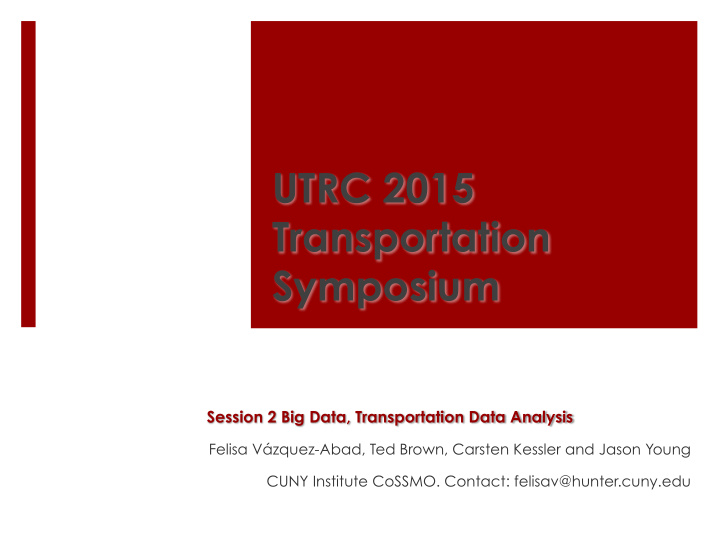



UTRC 2015 Transportation Symposium Session 2 Big Data, Transportation Data Analysis Felisa Vázquez-Abad, Ted Brown, Carsten Kessler and Jason Young CUNY Institute CoSSMO. Contact: felisav@hunter.cuny.edu
The Public Bikes Integrating information technology for a self- regulated PBS Felisa Vázquez-Abad, 2015
Why the hype? • From 1870’s development of the “bicycle” machine. • Famous bicycle playing cards introduced to motivate use as vehicles • Transportation alternative for individuals. • Mass production from 1890’s • II World War: shortage of petrol, ubiquitous in all cities in Europe. • Women, children and minorities are statistically the most prominent users. Felisa Vázquez-Abad, 2015
Back to the Future? • > 50% world population lives in cities • By 2050 population > 9 billion • New twist in bike hype: a sustainable alternative for public transportation • Well suited to inner city travel • Healthier, energy efficient, … and fun! Bikes are good for sustainable cities. Felisa Vázquez-Abad, 2015
Comparison Vehicle Distance Space required Negative Impacts car drop off point to Space inefficient Environmentally unfriendly destination bus Surface traffic Space efficient Additional wait time, have to share slows it down with others, Since it is public, less contro subway Often not close to Space efficient Additional wait time either at either end Bicycle rental Needs return at Space efficient Not good in wet weather origin taxi Close Expensive, space Additional wait time inefficient skate board can be carried to space efficient accident prone, only good for a few the office Felisa Vázquez-Abad, 2015
Brief History of PBS • 1 st Gen (1965) Amsterdam White Bikes, many to follow. • Vandalism • Misuse • Theft • 2 nd Gen (1995) Copenhagen “bike library”: borrow with a deposit, many to follow • Users are not registered, so not accountable • Theft, misuse • 3 rd Gen (1998) Rennes, Lyons: use of “smart card” technology • User identification • Information, monitoring, etc Felisa Vázquez-Abad, 2015
2007: the “vélib” comes to Paris It impacts the rest of the world. The tipping point
s e i r t n u o Statistics: PBS is here c 2 5 , n s m i s a e r i g t i c o r 0 p 0 n 6 g to stay! a n e i h r m a t o h e s r s o - e , 4 m k 1 i b 0 f o 2 d y t e e l r c a e n l e f a d n v e I d n a i b t m s o . o s h e c l c a y h c t i i b w 0 0 0 , 0 7 5 Spain leads the world with 132 separate bike-share programs. Italy has 104, and Germany, 43. The world’s largest bike-sharing program is in Wuhan, China’s sixth largest city, with 9 million people and 90,000 shared bikes. In 2013, China was home to 82 bike-sharing The United States hosts 36 modern bike- programs, with a whopping combined fleet of some sharing programs. With a number of 380,000 bicycles. new programs in the works and planned expansions of existing programs, the U.S. fleet is set to nearly double to over 37,000 publicly shared bicycles by the end of 2014. Felisa Vázquez-Abad, 2011
Transportation not recreation Public asset for sharing Public Bike Share Felisa Vázquez-Abad, 2015
How did Paris achieve this goal? • Short distance, shared bikes • Any time, anywhere, for “free” • Discourage “recreation” trips • Access fee: • Annual memberships • Short term memberships • Usage fees: • Above 30-45 minute ride • Geometric progression: $7, $14, etc, $441 for three hours! Felisa Vázquez-Abad, 2015
Is it working? Felisa Vázquez-Abad, 2015
The time limit Unlimited number of rides, but each with a time limit, Why do this? People learn: find a dock, • park and get another bike Drivers may rush to park in • time, and risk accidents Today 33% revenue in US PBS • comes from usage fees Significant revenue at Risk Negative Impact on Safety Negative Impact on Availability Felisa Vázquez-Abad, 2015
Our Vision of the Future for the 4 th Gen PBS Availability. Failures if no bikes or no docks when needed. We model customer behavior. Satisfaction. People become anxious facing uncertainty. Confirmation bias: tendency to blow up perceived confirmation and to overlook information disagreeing with our expectations Solution 1: Software based changes only Solution 2: . Pricing alternative Pilot simulations show feasibility, on-going study. Felisa Vázquez-Abad, 2015
Solution 1: Integration of information about the ride, probabilistic model for prediction, monitoring rides to trigger warning alarms. Optimization algorithms. • Reduced distance traveled (no waste finding docks) • Reduced maintenance costs • Increased availability • Reduced uncertainty and anxiety for customers • Increased safety in riding Felisa Vázquez-Abad, 2015
Solution 2: Economic model for pricing alternatives. Users Base Casual Memberships TP SR A Sh C Availability Simplified schematic dynamics. Ongoing: stochastic analysis of dynamic system with feedback for optimal balance (economic equilibrium) Felisa Vázquez-Abad, 2015
Our Vision for the 4 th Gen PBS • Integration of data analytics (GPS, customer classes, preferences, patterns, multimodal transport) • Humans as users but also as sensors/ agents • Incentivize redistribution by reward systems • Allow reservations Self-regulation: use information for • Dock/bike dynamic reallocation • Maintenance, expansion • Dynamic yield management Felisa Vázquez-Abad, 2015
results feed into PBS Model controls Simulator Computer simulation Real-world testing Evaluation controls results feed into Bikes communicates use with Human Participants Tests Central Agent App Bike Docks Fine-tuning System Overview
Research Team ¡ Felisa Vázquez-Abad: stochastic optimization, probability theory, mathematical models. ¡ Ted Brown: simulations, data gathering, apps development. ¡ Carlsten Kessler: Geo-positioning expertise, analysis of geographical data. ¡ Jason Young: behavioral psychology, modeling human reactions and behavior Open to establish public/private collaborations in NYC. Felisa Vázquez-Abad, 2015
Thank you!
Recommend
More recommend